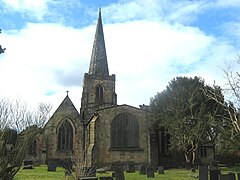Duffield, Derbyshire
| Duffield | |
|---|---|
 St Alkmunds Church |
|
| Duffield shown within Derbyshire | |
| Area | 7.859 km2 (3.034 sq mi) |
| Population | 5,046 (2011 census) |
| • Density | 642/km2 (1,660/sq mi) |
| OS grid reference | SK351476 |
| Civil parish |
|
| District | |
| Shire county | |
| Region | |
| Country | England |
| Sovereign state | United Kingdom |
| Post town | BELPER |
| Postcode district | DE56 |
| Dialling code | 01332 |
| Police | Derbyshire |
| Fire | Derbyshire |
| Ambulance | East Midlands |
| EU Parliament | East Midlands |
| UK Parliament | |
Duffield is a south Derbyshire village in the Amber Valley district of Derbyshire, 5 miles (8.0 km) north of Derby. It is centred on the western bank of the River Derwent at the mouth of the River Ecclesbourne. It is within the Derwent Valley Mills World Heritage Area and its elevated surroundings are the southern foothills of the Pennines.
There have been humans in the area, probably, from the Iron Age. A paleolithic hand axe has been discovered near the head of the River Ecclesbourne at Hopton. In the Duffield area itself, settlement by the Celts occurred in 400BCE. Although it has been suggested that, once farming began, they would have inhabited the plains of the Derwent and Ecclesbourne, they would most likely have retreated to higher ground during the winter floods.
The Romans arrived in the area in 43CE. It has been suggested that they built a fort to protect the ford across which the caravans of lead from Wirksworth joined Rykneld Street at Derby, en route for the North Sea ports, though this is disputed.
A few remains have, however, been found of Anglo-Saxon occupation by a person, or persons, of some substance. The Domesday Survey records "Duvelle" as being within the wapentake or hundred of Morleystone. In Norman times, Duffield Castle was built to protect the hunting grounds of Duffield Frith, awarded to Henry de Ferrers (or de Ferrars) by William I. Most of this became the ancient parish of Duffield, which contained the townships of Hazlewood, Holbrook, Makeney, Milford, Shottle, and Windley, and the chapelries of Belper, Heage, and Turnditch.
...
Wikipedia

